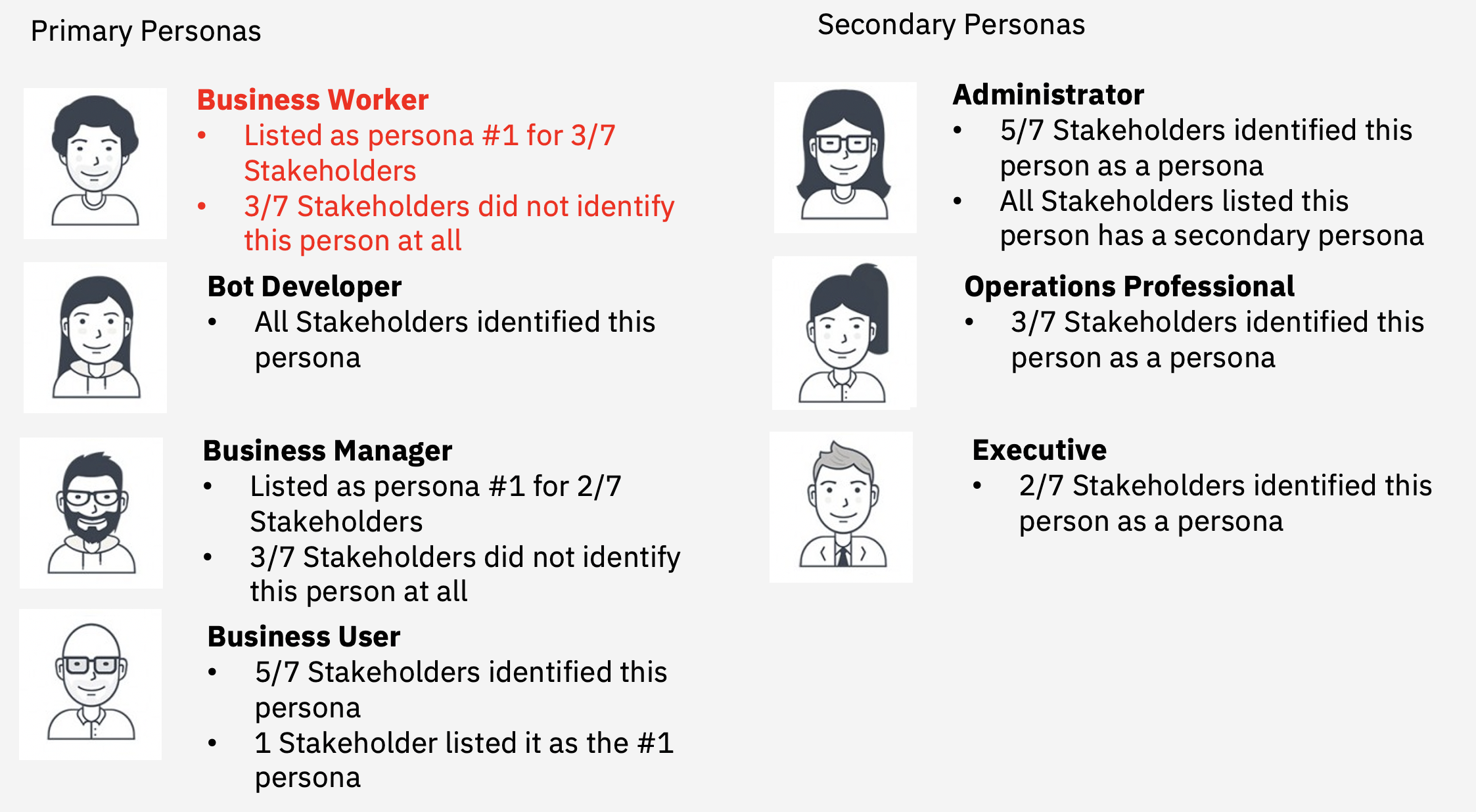Post-Acquisition Stakeholder Alignment
Context
In 2020, IBM had just acquired the company WDG Automation, gaining new RPA technologies to help provide enterprise automation services amid the COVID-19 pandemic. My role on this team was to bring together the WDG Automation team, a small Brazil-based startup into IBM, an American multinational technology company.
Therefore, I conducted stakeholder interviews to determine where there was misalignment with our team. After determining where there were misalignments, I then conducted a stakeholder workshop with the team in order to identify assumptions and concerns associated with the product and it’s end users, which lead to priority mapping and a research roadmap for 2021.
The objective of the stakeholder interviews was twofold:
Interface with stakeholders to help ensure that the team is aligned with project priorities
Develop a research plan aimed at helping identify factors that build value for IBM RPA customers
Tools: Mural
Methods Used: Stakeholder Interview
Participants: 7 Stakeholders
Timeframe: 2 months
Stakeholder Interviews
The script for the stakeholder interviews was determined by targeting areas where there was most misalignment around the project team. The interview with each stakeholder was then split into the following sections, with some example questions below:
Project
How would you, personally, define success for this project?
What are any restrictions, that will prevent you from achieving success for this project?
Competition
Who do you see as our top competitors in this market?
How will our offering be different?
Research
What are the assumptions you have that you'd like to test?
What are the big user research questions you'd like answered?
Persona Activity
Following the interviews, I then took participants through a persona activity, to get a better sense of who they believed we needed to focus on designing for. I provided participants with blank personas, and had participants fill the personas in.
I then repeated the process with other proto-personas. I asked participants to describe users that they thought were primary and secondary personas. After identifying 5 proto-personas, I then asked users follow up questions regarding each persona:
What defines success for this person? (if the our experience goes well, what happens?)
What about bad results for this person? (if the our experience doesn’t go well, what happens?)
After the interviews with participants were complete, I aggregated the results on Mural boards and clustered the data across participants to find common themes.
Results: Stakeholder Interviews
In terms of the interviews, our stakeholders were fairly aligned on aspects of the project such as project vision, restriction, competitors and the white space we will occupy.
Project Vision
Our participants mentioned that project success will be defined by delighted customers, revenue, successful integration and customers leveraging the full future set.
Project Restrictions
Restrictions that could prevent project success includes having a limited staff, software not being up to IBM standards, limited time, and teams from WDG and IBM (engineering, management, development, design, etc.) not working well together.
Competitors
The stakeholders emphasized that our competitors in the market have good marketing launches, are more RPA-focused, have enterprise ready platforms, and incorporate low-code capabilities.
Results: Persona Activity

The personas identified by our stakeholders were clustered, and we found 7 categories of end users for our product.

The results found that there was misalignment revolved around the personas themselves. For example, the business worker was listed as the #1 persona for 3/7 stakeholders, however, another 3/7 stakeholders did not identify this person at all. The other personas can be seen in detail below.
Readout
In the playback to the team, we emphasized that the key takeaway from our stakeholder interviews was that there is a vast misalignment of who we’re designing this product for.
Half of the stakeholder believed we are designing for a non-technical Business worker, and another half of the stakeholders believed we are designing for the technical Developer.
As a result of the stakeholder interviews, it was determined that there was a need to align on our user base and have input from stakeholder regarding top research priorities.
Following the stakeholder interviews, I conducted a stakeholder workshop in order to develop a research roadmap that would be prioritized by impact of research.


